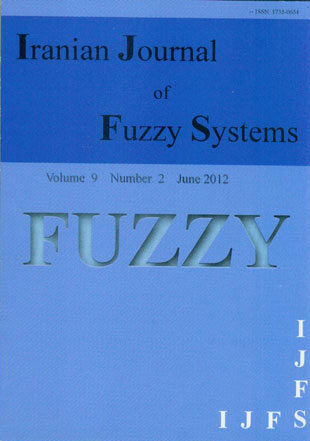فهرست مطالب

Iranian journal of fuzzy systems
Volume:9 Issue: 2, Jun 2012
- 176 صفحه،
- تاریخ انتشار: 1391/04/20
- تعداد عناوین: 10
-
-
Page 1In this paper, we study the existence, asymptotic behavior of the positive solutions of a fuzzy nonlinear difference equation $$ x_{n+1}=\frac{Ax_n+x_{n-1}}{B+x_{n-1}}, \ \ \ n=0,1,\cdots,$$ where $(x_n)$ is a sequence of positive fuzzy number, $A, B$ are positive fuzzy numbers and the initial conditions $x_{-1}, x_0$ are positive fuzzy numbers.
-
Page 13The generalized fuzzy valued Θ-Choquet integrals will be estab- lished for the given μ-integrable fuzzy valued functions on a general fuzzy measure space, and the convergence theorems of this kind of fuzzy valued in- tegral are being discussed. Furthermore, the whole of integrals is regarded as a fuzzy valued set function on measurable space, the double-null asymptotic additivity and pseudo-double-null asymptotic additivity of the fuzzy valued set functions formed are studied when the fuzzy measure satis es autocontinuity from above (below).
-
Page 25In this study, the roll, yaw and depth fuzzy control of an Au- tonomous Underwater Vehicle (AUV) are addressed. Yaw and roll angles are regulated only using their errors and rates, but due to the complexity of depth dynamic channel, additional pitch rate quantity is used to improve the depth loop performance. The discussed AUV has four aps at the rear of the vehicle as actuators. Two rule bases and membership functions based on Mamdani type and Sugeno type fuzzy rule have been chosen in each loop. By invoking the normalized steepest descent optimization method, the optimum values for the membership function parameters are found. Though the AUV is a highly nonlinear system, the simulation of the designed fuzzy logic control system based on the equations of motion shows desirable behavior of the AUV spe- cially when the parameters of the fuzzy membership functions are optimized.
-
Page 43This paper focuses on the non-fragile guaranteed cost control problem for a class of T-S fuzzy time-varying delay systems with local bilinear models. The objective is to design a non-fragile guaranteed cost state feedback controller via the parallel distributed compensation (PDC) approach such that the closed-loop system is delay-dependent asymptotically stable and the closed-loop performance is no more than a certain upper bound in the presence of the additive controller gain perturbations. A sufficient condition for the existence of such non-fragile guaranteed cost controllers is derived via the linear matrix inequality (LMI) approach and the design problem of the fuzzy controller is formulated in term of LMIs. The simulation examples show that the proposed approach is effective.
-
Page 63In this study we introduce the concepts of statistical convergence of order β and strong p-Cesaro summability of order β for sequences of fuzzy numbers. Also, we give some relations between the statistical convergence of order β and strong p-Cesaro summability of order β and construct some interesting examples.
-
Page 75This paper deals with ridge estimation of fuzzy nonparametric regression models using triangular fuzzy numbers. This estimation method is obtained by implementing ridge regression learning algorithm in the La- grangian dual space. The distance measure for fuzzy numbers that suggested by Diamond is used and the local linear smoothing technique with the cross- validation procedure for selecting the optimal value of the smoothing param- eter is fuzzi ed to t the presented model. Some simulation experiments are then presented which indicate the performance of the proposed method.
-
Page 89In this paper, the problems of robust stabilization and H∞ control for uncertain stochastic systems with multiple time delays represented by the Takagi-Sugeno (T-S) fuzzy model have been studied. By constructing a new Lyapunov-Krasovskii functional (LKF) and using the bounding techniques, sufficient conditions for the delay-dependent robust stabilization and H∞ control scheme are presented in terms of linear matrix inequalities (LMIs). By solving these LMIs, a desired fuzzy controller can be obtained which can be easily calculated by Matlab LMI control toolbox. Finally, a numerical simulation is given to illustrate the effectiveness of the proposed method.
-
Page 113An orthogonal approach to the fuzzi cation of both multisets and hybrid sets is presented. In particular, we introduce L-multi-fuzzy and L-fuzzy hybrid sets, which are general enough and in spirit with the basic concepts of fuzzy set theory. In addition, we study the properties of these structures. Also, the usefulness of these structures is examined in the framework of me- chanical multiset processing. More speci cally, we introduce a variant of fuzzy P systems and, since simple fuzzy membrane systems have been introduced elsewhere, we simply extend previously stated results and ideas.
-
Page 127The paper is concerned with robust stability criteria for Takagi- Sugeno (T-S) fuzzy systems with distributed delays and time delay in the leakage term. By exploiting a model transformation, the system is converted to one of the neutral delay system. Global robust stability result is proposed by a new Lyapunov-Krasovskii functional which takes into account the range of delay and by making use of some inequality techniques. Based on the interval time-varying delays, new stability criteria are obtained in terms of linear matrix inequalities (LMIs). Finally, three numerical examples and their simulations are given to show the effectiveness and advantages of our results.
-
Page 147Based on a complete Heyting algebra, we modify the definition of lattice-valued fuzzifying convergence space using fuzzy inclusion order and construct in this way a Cartesian-closed category, called the category of L- ordered fuzzifying convergence spaces, in which the category of L- fuzzifying topological spaces can be embedded. In addition, two new categories are introduced, which are called the category of principal L- ordered fuzzifying convergence spaces and that of topological L- ordered fuzzifying convergence spaces, and it is shown that they are isomorphic to the category of L-fuzzifying neighborhood spaces and that of L-fuzzifying topological spaces respectively.

